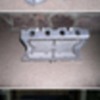Recently, I was asking questions here about fitting a quad-Weber setup under the deck lid.
The answer was that IDA's will not fit; the rear deck needs to be notched. However, the lower-profile IDF should fit, given the right manifold. (The IDF appears to be a better street carburetor than the IDA as a side benefit.)
While browsing the web tonight, I found this wildv8 page at carburation.com. Part way down the page they show a 351c setup for 4 x 48 IDFs (search for K351c-IDF).
I'm not ready to buy this yet (too much other stuff to buy first), but maybe someone else is interested; I know George is.
If anyone goes for these or asks questions about them, I would be really interested in the result.
Thanks,
Original Post


